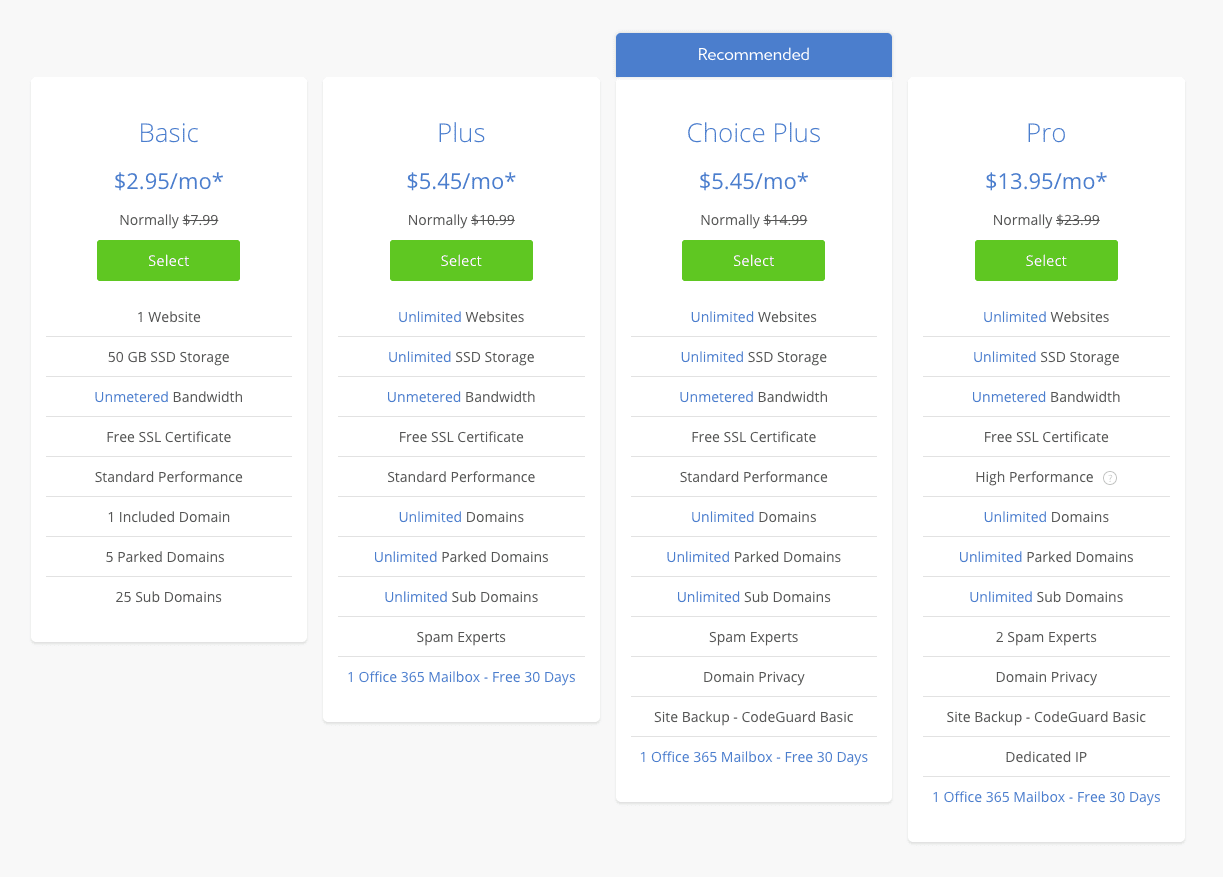Starting a blog is one of the most rewarding ventures you can pursue.
Whether your goal is to build a full-time career, start a new side hustle, or simply write about what interests you, you can benefit from blogging.
Blogging can provide you with passive income, flexibility, and a network of incredible people to connect with.
I’ve been able to make over a million dollars with Millennial Money, and for a few dollars a month, you can start making money blogging, too.
With the simple step-by-step guide below, you’ll be on your way to starting a profitable blog on Bluehost in a few minutes’ time.
Ready to get started?
Why Start a Blog on Bluehost?
Before we dive into how to start a blog, here’s a quick word on why you should blog with a platform like Bluehost.
When you jump online to start a blog, you may be tempted to launch your site on a platform like Blogspot or Blogger. These sites are known as free hosted blogs.
They promise simple site management and they may save you a few bucks when you sign up, but here’s the problem.
When you opt for a free hosted platform, you don’t actually own your website’s domain, your design options are limited, and you’ll have a difficult time if you ever decide to move your blog to another site. But there’s more.
Make More Money with Bluehost
If you ever want to make money blogging, it’s critical that you build a WordPress site on Bluehost or a similar self-hosted platform.
For one, advertising and affiliate marketing are challenging on free blogging sites, as advertisers don’t see these sites as legitimate professional partners.
Bluehost Lets You Own Your Domain Name
By building a WordPress blog on Bluehost, you get your own domain name (milliennialmoney.com looks a lot more legitimate than millennialmoney.blogspot.com), the freedom to customize everything on your site, and the ability to make more money with strategic ad placement and SEO tactics.
In the grand scheme of things, paying a monthly fee for hosting is well worth the cost. And fortunately, Bluehost’s monthly costs are lower than your streaming subscriptions.
Create a Blog on Bluehost in 5 Easy Steps
Without further ado, here’s the beginner’s guide to creating a blog with Bluehost, broken down into five simple steps.
1. Choose Your Niche
Before you head over to Bluehost to set up your account, you need to do a little brainstorming. If you’ve already landed on a niche, you can skip ahead to get started.
Otherwise, you may want to grab a pen and paper. Step one to starting a great blog is deciding what topic to write about. This step is crucial, especially if you ever plan to make money on your blog.
As you set out to choose a topic, take the following factors into consideration.
Your Passion
Just because a blogger finds success in a particular niche doesn’t necessarily mean you should start writing on the same subject.
It doesn’t matter how profitable or SEO-friendly a topic is if you aren’t captivated by it.
When you’re passionate about a subject, it seeps into your writing and better engages your audience.
Passion is also highly motivating, giving you the fuel you’ll need to get through those long nights of researching and writing.
Chances are, you’ve come to this post with a topic in mind. However, if you need a little help identifying potential topics, look to your hobbies, the media, and even classes you took in high school or college. Which ones intrigued you?
You should also look to your career, if you’re passionate about what you do. If you’re starting a blog to get away from a passionless career, no worries.
Think of your dream job, the one you’d be pursuing if there were no financial constraints. Chances are, there’s a blog topic waiting to be pursued there.
Your Experience
As you decide what niche to write in, you should try to couple your passions with your knowledge.
While you can definitely blog on a topic you aren’t familiar with, you’ll find the most success and fewest headaches by writing what you know.
Take advantage of your unique experiences and put your expertise to work on your blog, using your specialized knowledge to build authority on your site.
Consider how your personal and professional experiences could fit into your blog, adding value to the content you write.
Research Your Niche
With a list of ideas in mind, you need to research your topic determine how best to approach it.
Thanks to keyword research tools, you can see what readers are searching for and build your site accordingly.
In some industries, you can benefit from writing a super-niche blog that’s laser-focused on one topic.
In other fields, like personal finance, you may choose to branch out and cover a multitude of financial topics.
As you decide how focused or broad your site should be, think of what all types of content you want to write, not just today, but five years from now.
If you want to make money blogging, you also need to research to see just how steep the competition is in your niche and how much room there is to make a profit.
Start out with a basic Google search to gauge your competition at the surface level, entering keywords you plan to focus your content around.
Then, use a tool like SEMrush to actually assess how many people search your topic on a monthly basis.
For a topic to be worth your while, keywords in your niche should have a monthly search volume of around 5 to 10,000. Any less, and the niche probably isn’t profitable. Beyond that volume, you may have a hard time competing.
Bottom Line: Follow your heart, use your insights, and do your research to choose the right niche for your blog.
2. Pick and Purchase Your Domain Name
Hand in hand with picking a niche is crafting the perfect name for your site. This is a crucial step that deserves some time and attention.
Choose a Name
Your whole brand, not just the URL that houses your content, will be built around whatever name you choose.
With that in mind, you need to pick a name that relates to your topic.
Whether you’re going to be writing about sewing or travel or college sports, you need to pick a name that people associate with that subject.
Your pen and paper will come in handy here. Take a few minutes (or more) to brainstorm names related to your niche.
As you tap into your creativity, try to aim for 10 or 20 names that are:
- Short and Simple: Keep your domain name short and to the point so users can easily spell it and search it.
- User-Oriented: As you craft a title, think about your target audience. Consider who will be coming to your site, what they’re looking for, and what type of title might draw them in.
- Relevant to Your Niche: The scope of your site is important here. Whether you choose to keep it broad or have a narrowly focused site, your title should reflect the scope of the content on your blog.
- Memorable: Make your title stand out so people won’t quickly forget it. Craft a title someone can hear once and remember to search.
- Creative: Along those lines, be creative! Break out a thesaurus. Attempt alliteration or make a play on words. Just make sure your title reflects your brand and the voice of your content.
- Competitive: The most successful bloggers in your niche didn’t get there by chance. Take a look at their titles and consider crafting yours with similar techniques or keywords.
Purchase Your Domain
Although you could purchase a domain name on a site like GoDaddy then connect it with the hosting site of your choice, I recommend registering your domain and purchasing hosting all at once with Bluehost.
When you purchase 12 months of hosting through Bluehost, which you should, you’ll get your domain name for the first year, free of charge.
And when you opt for 12 months or more of hosting, your monthly price is lowered, offering even more savings.
When you sign up for Bluehost, you can search to see if any of your blog names are available, securing the domain name of your choice.
In the next step, you can find a more in-depth summary of the signup process.
3. Buy Hosting Through Bluehost
With your creative decisions made, it’s time to get your blog up and running.
To take your site from dream to reality, you need to find a host for your site, which houses your content and protects your files and your users.
Purchasing hosting is simple with Bluehost and can be done in just a few minutes.
You can sign up by clicking “Get Started” on Bluehost’s home page, which will take you to Bluehost’s available hosting plans.
Bluehost offers Four Hosting Plans:
- Basic
- Plus
- Choice Plus
- Pro

*prices reflect Millennial Money discount
When you’re just starting out, the Basic or Plus plans should give you all the features you need at a manageable cost.
If your site grows and you find yourself in need of more bandwidth later, you can upgrade your plan and simply pay the difference.
With Bluehost’s current promotion, you can purchase Basic Hosting for as little as $3.95 a month.
With your package selected, you’ll be prompted to choose a domain name, as I mentioned earlier. You can also opt to finish registration and pick a domain name later, free of charge.
Once you’ve selected a domain name or chosen to do it later, you’ll be asked to enter your account information and proceed to payment.
The Best Deal with Bluehost is a 60 Month Plan
While you can choose to buy as little as 12 months of hosting, you’ll ultimately save money by purchasing more, with the 60 month plan saving you the most money.
If you’re serious about your blog and see yourself publishing on it 5 years from now, the savings of a 60-month plan are well worth it.
When you proceed to payment, you’ll be presented with a few available add-ons. The one you’ll probably want to purchase is Domain Privacy Protection, which protects your contact information from the public.
Once you enter your payment information and accept the terms and conditions, you’ll get a welcome message from Bluehost and a confirmation email, prompting you to create a password.
Then you’re all set!
4. Install WordPress
With all of the technicalities squared away, it’s time to start building your blog. Once you’ve purchased your hosting with Bluehost, your next step is to install WordPress, which I’ll walk you through here.
WordPress is a content management system which helps you to organize, structure, and manage your blog content.
It comes with design tools and loads of themes to choose from, making the design process as involved as you want it to be.
If you plan to make money blogging, WordPress is the clear winner among content management systems.
WordPress.com vs WordPress.org
Before we dive into how to install and use WordPress, you need to understand what WordPress actually refers to in this context, because there are two WordPress platforms.
Let’s take a look at the key differences between them.
WordPress.com is a free hosting site similar to Blogspot, Wix, or Weebly. As such, it comes with restrictions on monetization, SEO, and design.
WordPress.org, on the other hand, works in conjunction with Bluehost and other hosting sites.
WordPress.org allows you to customize every aspect of your blog, with numerous plugins and themes, full rein to monetize your site, and some awesome SEO tools to help put your website on people’s radars.
In addition to all those benefits, it couldn’t be easier to use with Bluehost.
Start Using Bluehost
When you use Bluehost, WordPress is automatically installed.
Once you complete the steps above and create a password, Bluehost will walk you through the process of starting your WordPress blog.
- Choose a Theme: The first thing you’ll do is select a theme. If you need more time to think about the design of your blog, you can pick a generic theme or skip to the next step. There are plenty of free themes and paid ones to choose from.
- Start Building: After you review the WordPress themes, all you have to do is click “Start Building.”
- Pick a Blog Type: The next optional step is to choose between a Business and Personal blog, which gives you access to the most suitable tools for your needs.
- Manage Plug-ins: After selecting your blog type, you’ll be taken to a dashboard where you can manage your content and your plug-ins, which I’ll cover below.
- Create a Title and Description: Last, you’ll be prompted to name and write a description for your blog, which can be altered in the future.
Once you complete the simple steps above, you can dig into writing content!
Tips for Choosing a Theme
Whether you choose the perfect theme when you set up your WordPress site or decide to double back to pick the right one later, here are a few pieces of advice to guide you along the way.
- Don’t go Crazy: There’s no shortage of cool themes that think outside the box, but not all of them are ideal for your blog. Keeping your site clean, simple, and accessible is key to engaging your audience and presenting them with a great user experience.
- Be Responsive: I’m not talking about responding to your readers’ emails. Users come to websites on smartphones and computers. Templates that are designed to adapt and look good on both mobile and desktop devices are deemed responsive. Make sure the one you choose is optimized for mobile devices as well as desktop. Your readers, and Google, will thank you.
- Check for Plug-ins: Make sure the theme you choose will support plug-ins you plan to add to your site as some themes are limited.
- Read Reviews: As you’ll learn in the blogging world, product reviews are your friends. See what users have to say about a theme’s functionality before you jump into using it, especially if it isn’t free.
WordPress Settings
You’ll have lots of WordPress settings to work through as you get deeper into blogging, but there are a few basic ones to be aware of from the get-go to give your blog the SEO foundations it needs to succeed.
- Permalinks: From the main settings page in your WordPress dashboard, go to “Permalinks” and make sure your post name is set to https://domain.com/post-name. That way your site’s name will be in every post, helping your Google rankings.
- URL: You should also make sure that the URL for your website’s posts includes a “www,” which is an industry standard that adds credibility to your content.
- Homepage: Your homepage can serve a number of purposes, connecting you with your readers and showcasing your most prolific posts. A lot of bloggers feature previews of their most recent posts there, which can be a good strategy when you’re just starting out.
- Menu: After building your site’s main pages, like Contact, Blog, and About, you’ll want to customize your site’s navigation, which can be done in “Appearance” on your WordPress dashboard.
5. Make Money Blogging
Once you’ve got everything set up, it’s time for the fun to begin!
Develop a Content Strategy
After you get everything squared away with hosting and designing your WordPress site, you need to develop a content strategy.
Rather than just hacking away at your keyboard and writing on whatever you feel like that day, take the time to plan out posts ahead of time.
As you try to decide what to write about, consider your competition, your audience, and your goals for the site.
From there, you should determine what your pillar pieces of content will be. These posts will serve as the cornerstone posts, under which you can build out more content in the future.
You should also use keyword research as you strategize content, looking to data to help you decide what to write next.
Then, map out your strategy with a tool like Google Docs or Sheets where you can easily track your progress.
Build an Editorial Calendar
Once you know what content you plan to publish, you need to build a calendar around it.
Having a content calendar keeps you accountable and helps you to post consistently.
Getting in a publishing routine from day one is a great way to approach your blog and helps you to set a realistic publishing rate.
Start Writing
With your plans in place, you can confidently write your first blog post.
The key to a truly successful blog is quality content, so you should dedicate time to ensuring your posts are well-written, easily accessible, and user-oriented.
If you can check those boxes and answer your readers’ questions, you’re on the way to success.
With my Free 7 Day Blogging Side Hustle Email Course, you can learn the ropes of blogging to grow your traffic and make money!
Make Money Blogging
If you really want to grow your blog into a source of income, you have some work ahead of you. The first six or so months of blogging will require you to hustle with little monetary reward.
But if you put in the time and take the right steps, the hustle is worth it. In the early days of your blog, your main goal should be generating traffic.
That means you should double down on writing your pillar content and networking, guest posting on other sites and commenting on social media and other forums to get your name out there.
To really profit from affiliate links and ads, you need traffic. To get traffic, you have to build a platform.
As you work on networking and building connections in the blogosphere, stay focused on content quality.
While that may mean turning down some offers for partnership or spending more time polishing your writing, it will pay off (literally) in the long run.
Start Blogging with Bluehost Today
Looking back, I’m so glad I chose to follow the steps above and start a blog. Blogging has enriched my life in more ways than one.
Blogging isn’t a get-rich-quick scheme, but if you hustle and trust the process, blogging can provide you with a great source of income and a rewarding way to spend your time.
There’s nothing more fulfilling than doing what you love, helping people, and seeing the fruits of your disciplined efforts pay off.





Comments are closed.
Comments are closed here.